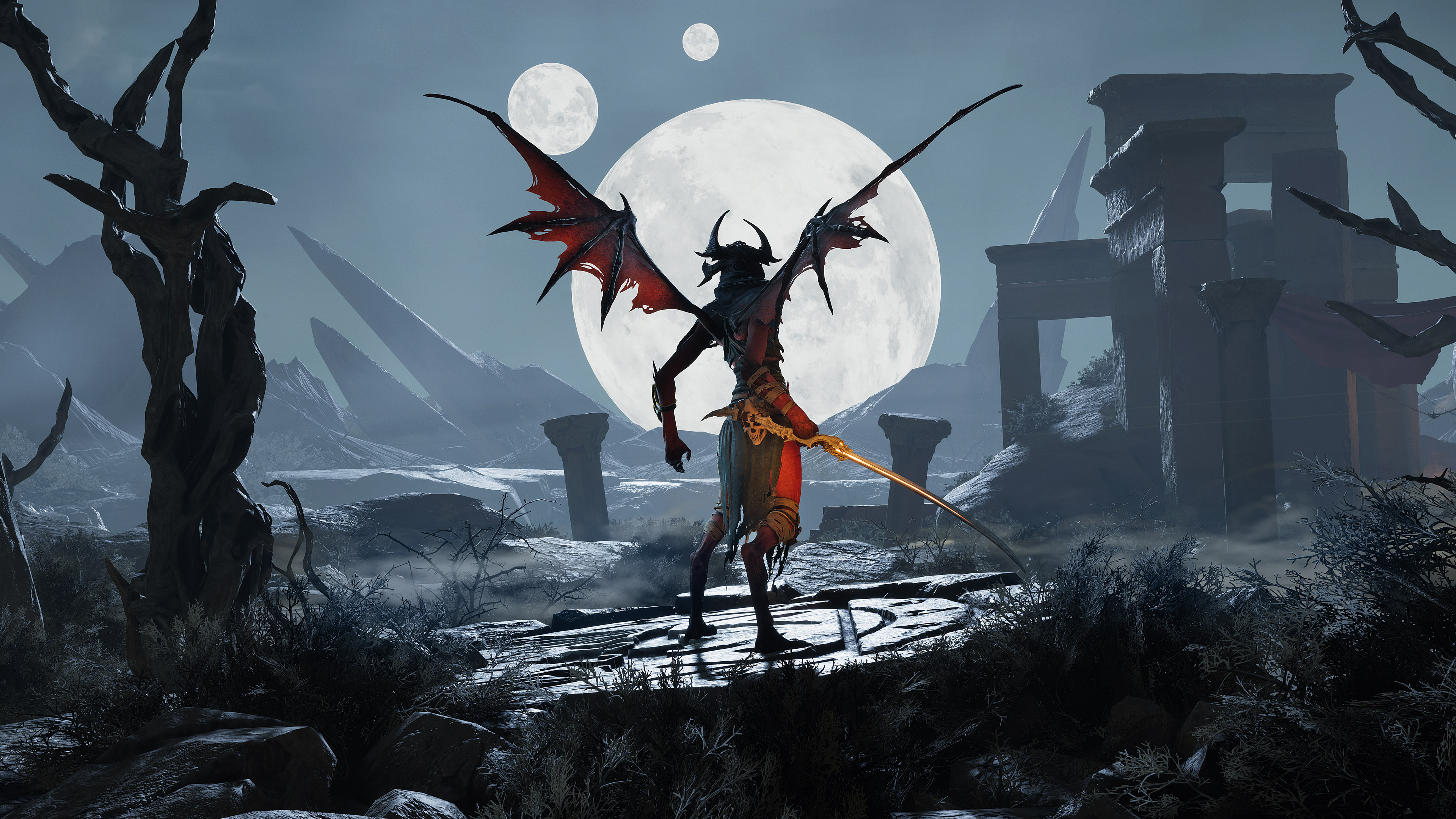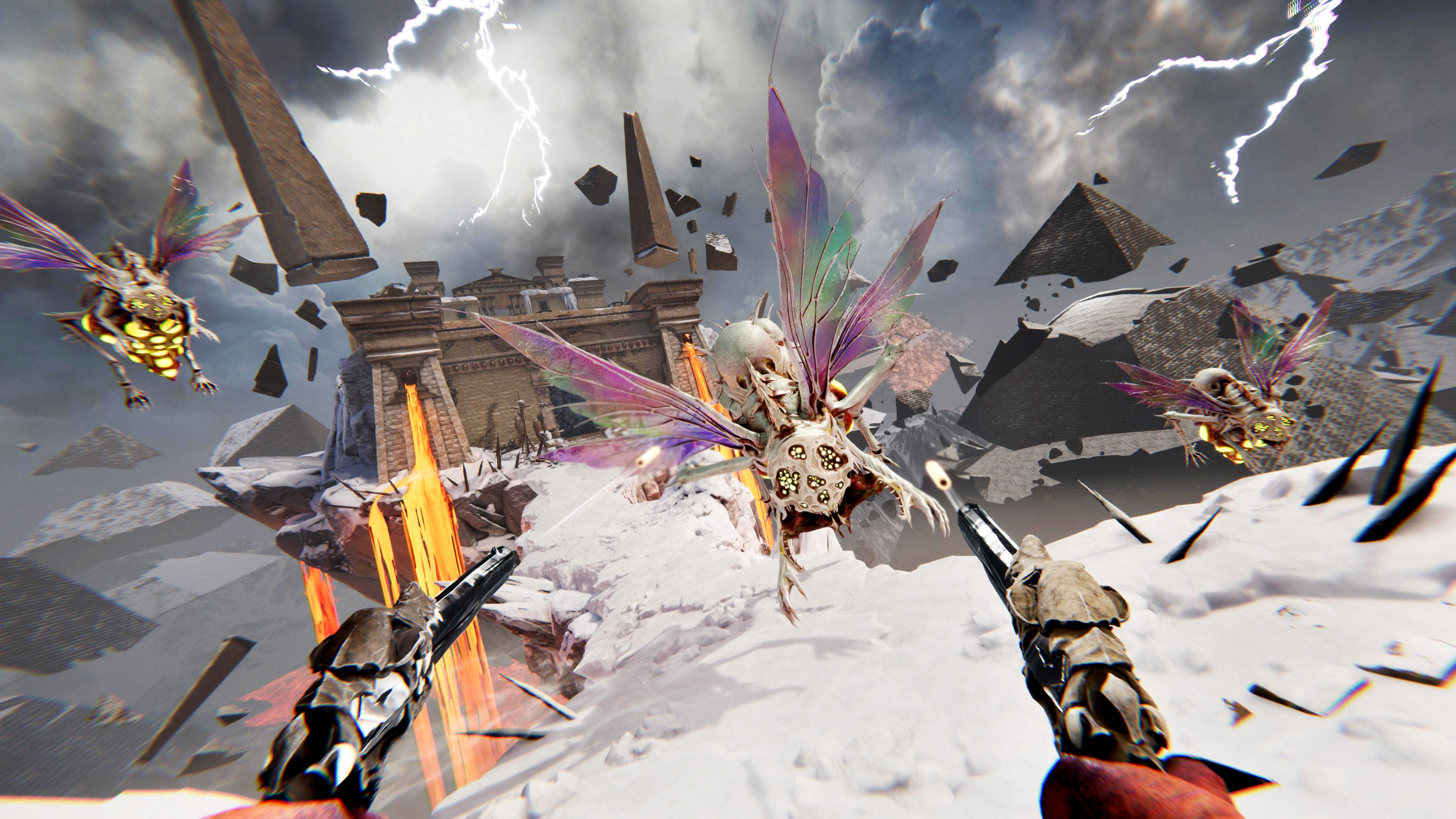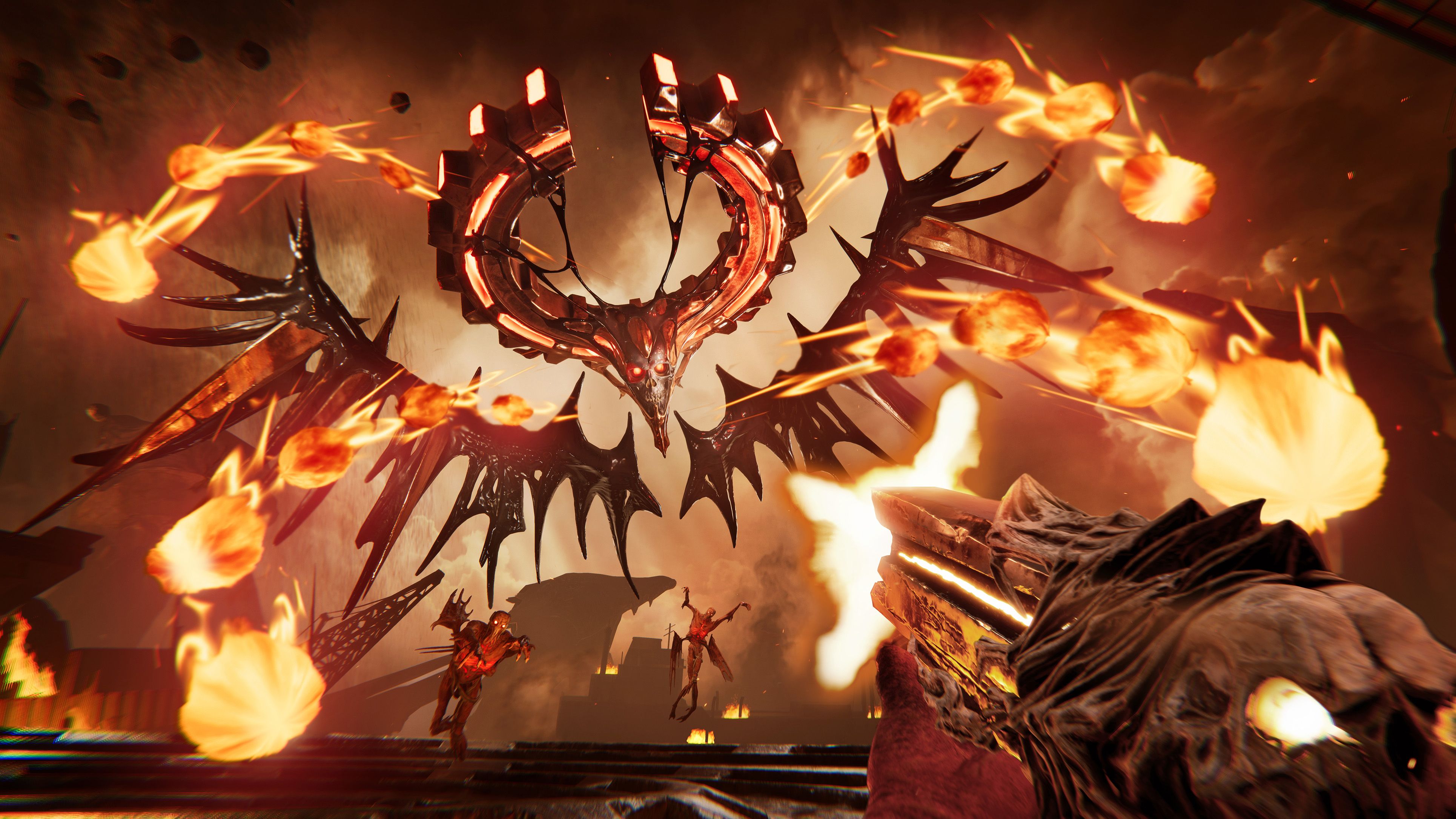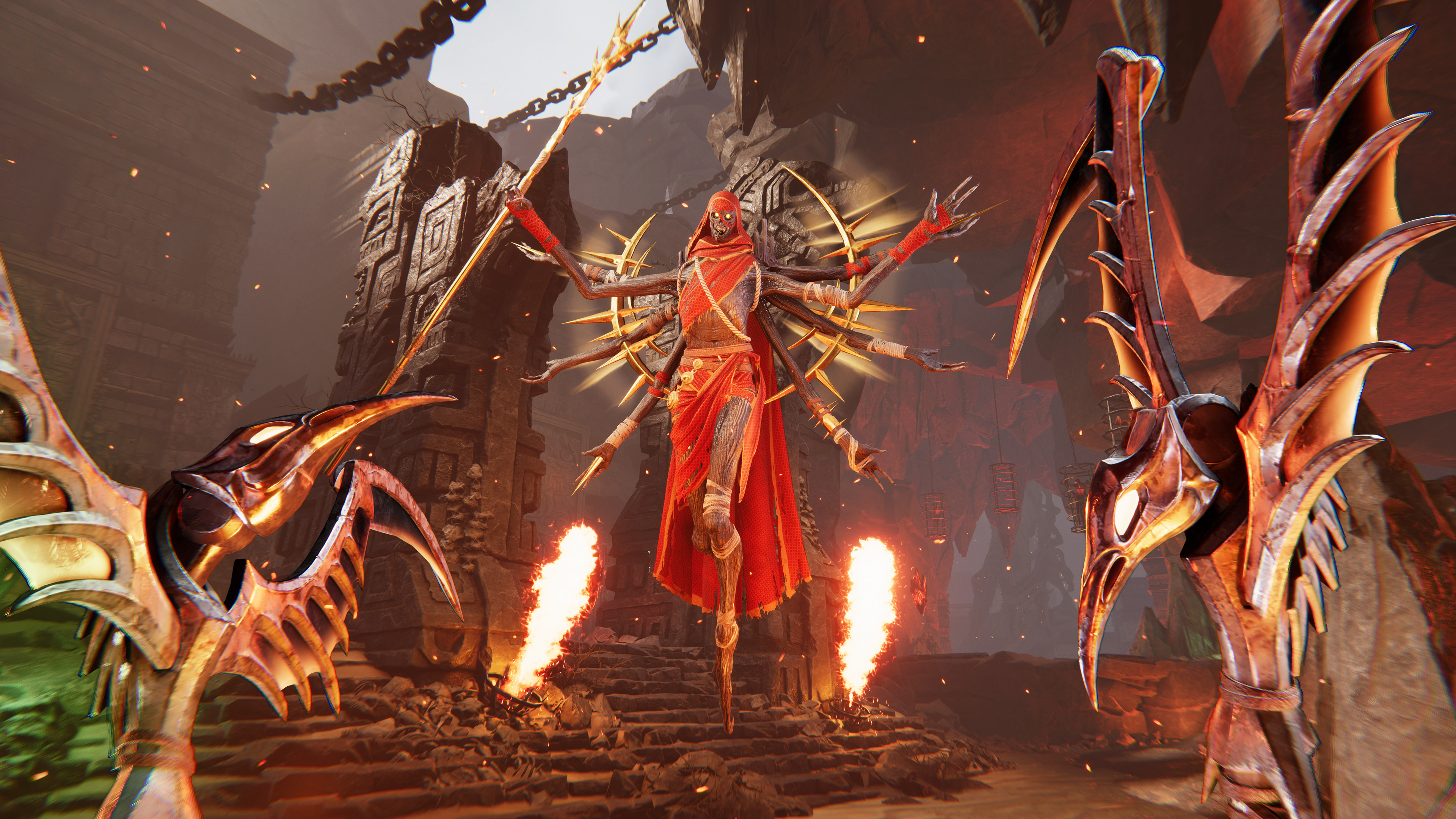Metal: Hellsinger recently launched to critical acclaim as a DOOM-inspired first-person shooter powered by an absolutely incredible metal album. Creating such a memorable soundtrack was no easy task, and we were fortunate enough to gain some insight into how it all came together.
I sat down with Elvira Björkman and Nicklas Hjertberg, the duo behind Two Feathers studio, known for its music in games like League of Legends, Warhammer: Vermintide 2, the Aragami franchise, and the entirety of Metal: Hellsinger. It required years of hard work and ingenuity to create a finished product that feels deceptively simple and seamless, and Björkman and Hjertberg shared how Metal: Hellsinger came to be, speaking with Windows Central.
Disclaimer: This interview has been edited for grammar and clarity.
It starts with an idea

“We were involved at the first,” Björkman tells Windows Central, when discussing Metal: Hellsinger’s beginnings. “When the whole team at The Outsiders got the news that we were making this game, we were actually in that meeting as well… It wasn’t sure that we were going to make music, but they really wanted us for sound design, which we also worked on for this game.”
“We had been working with The Outsiders before then because we were working on a different project that eventually never got released,” Hjertberg added. Music is integral to every facet of Metal: Hellsinger and the studio was involved from the very beginning.
However, Two Feathers wasn’t always guaranteed to craft the metal soundtrack. “We had to kind of re-pitch ourselves for the music, though… to prove our metal headedness,” said Björkman. Metal: Hellsinger’s soundtrack is bold and unapologetically loud, more so than other games that claim to possess such music, and the composing duo had to prove it was up to the task.
We just really wanted to make a metal album.
Elvira Björkman
Two Feathers’ inclusion in the creation of Metal: Hellsinger gave it a deeper insight into how the unique rhythm-based shooter came to be. Both composers recalled the origins as told to them by David Goldfarb, the creative director behind Metal: Hellsinger at The Outsiders. “I remember [Goldfarb] talking about… how he was playing DOOM (2016) while listening to Meshuggah, specifically ‘Bleed,'” Hjertberg said. “He started to accidentally, or maybe intentionally, hitting the shots to the beat of the track, and he thought, ‘Oh, that’s a cool idea.’ I think that was the seed of the idea.”
“[Goldfarb] had this idea for lots of years but was working on other games…That’s what we know from him. The game is very inspired by DOOM in that sense,” said Björkman. While Metal: Hellsinger’s FPS gameplay and setting are clearly inspired by DOOM, which also boasts a heavy soundtrack, Two Feathers wanted to ensure it still carved out its own identity. “Me and Nicklas, we were adamant that we not listen to Mick Gordon’s music,” Björkman said, “because we felt that’s not the music or vibe we were going for. We just really wanted to make a metal album.”

Metal: Hellsinger existed as a concept, ephemeral and wrapped in uncertainty, with The Outsiders and Two Feathers quick to begin work. For Two Feathers, everything depended on building the foundation for Metal: Hellsinger’s sound. “A lot of the early work for us was to make sure we knew what we were going to do… and figure out how the music, sound design, and systems should work,” Hjertberg said.
Of course, sound is integral to Metal: Hellsinger, with direct ties into gameplay and progression. The Outsiders valued the input of Two Feathers’ dual composers for this reason, according to Björkman. “We’re no game designers. That’s not what we normally do. But [The Outsiders] felt it would be inspiring to invite us to various meetings when it came to the rhythmical elements of the game, to see what musicians would suggest. Of course, we’ve worked so long with games, sound, and all the implementation work of music… We are very technically knowledgeable about the ins and outs of the tools we can use, what we can do, and so on. So, lots of the music execution that you see in the game is from our suggestions and ideas.”
Metal: Hellsinger is special because it carefully marries gameplay design with its music. A direction was chosen early on to ensure that the project never deviated from this vision. “In a lot of the early talks, the concept of the game was always… that the game should feel like you’re playing a metal album cover,” Hjertberg stated.
“Picking up an Iron Maiden vinyl and looking at all the art, and then you dive into that… We talked a lot about putting that into music as well… It should feel like you’re playing through a concert lineup.”
It should feel like you’re playing through a concert lineup.
Elvira Björkman
Creating such a soundtrack is easier said than done, with Metal: Hellsinger’s music requiring years of constant work and iteration to bring together. When playing Metal: Hellsinger, three separate facets of the soundtrack stood out to me: how it seamlessly transitions between Fury levels, how each song cleverly loops through its level, and how it features such an amazing list of talented and infamous metal vocalists.

Each song in Metal: Hellsinger’s soundtrack features vocals from some of the best artists in the industry, backed by music composed and recorded by Two Feathers. This list of guests includes names such as Tatiana Shmayluk from Jinjer, Alissa White-Gluz from Arch Enemy, Serj Tankian from System of a Down, and many more. It’s impressive regardless of context, but more so for an indie project.
“It always started with us writing songs, without really knowing who would sing on them,” Hjertberg said. “We knew that we were going to try and find a singer for each song, but we didn’t know exactly who yet. We needed to make sure that it fits the game.” Once a potential artist was found, the duo would consider altering the melodies, lyrics, and more of a song to better match that artist’s style. Of course, everything had to start with just one artist agreeing to participate.
It always started with us writing songs, without really knowing who would sing on them.
Nicklas Hjertberg
“The first to agree was Mikael Stanne [from Dark Tranquillity], and we’re forever thankful for that,” Björkman said, recalling the early stages of work on the Metal: Hellsinger soundtrack.
“[Stanne] jumped on to the project even during the prototype stage,” said Hjertberg. “We didn’t even know if this game was ever going to happen because we were pitching it.”
The inclusion of one noted metal vocalist provided the credibility to pitch to more artists. However, the process of building the artist list for Metal: Hellsinger still took over two years. With each addition to the lineup, Two Feathers became better at pitching its project to artists, even without being able to divulge much information on the game.
“We were blown away every time these artists sent their recordings, where we’re looking at each other like, ‘What is happening? How are we pulling this off?'” Björkman said. “Most of the time, we would talk with managers, and it didn’t feel like it was real until the moment we heard the actual voice.” But even when a song was recorded and completed, Two Feathers still had to make it fit.
Bringing it all together

Composing a riff-heavy metal album for Metal: Hellsinger’s soundtrack was important, but it wasn’t the entire story. Two Feathers also needed to design the music to fit within the confines of the game, and that meant mastering the dynamic Fury meter and looping.
The Fury meter in Metal: Hellsinger is a score multiplier that rises through four different levels (2x, 4x, 8x, and 16x), depending on how well you’re playing. Match the beat of the song, pull off executions, kills, and multi-kills, and tear through enemies quickly to raise the Fury meter. When the meter rises, so does the energy and volume of the music until the full song (including vocals) blasts at the max 16x Fury meter. While this sounds simple on paper, an enormous amount of work went into making it sound right.
“We started with writing the entire track and then started removing elements from it,” Hjertberg said. “When we had something that we thought was cool, we kind of made that its own version, that’s exactly the same length and everything. So when you transition between two different Fury levels, they crossfade between each other.” In simpler terms, each song in Metal: Hellsinger’s soundtrack is four separate tracks, each being a completely identical length. When you rise up a Fury level, the current track seamlessly blends into the next version.
This meant low Fury tracks would be similar to the full song, even if the necessary parts weren’t there. “This is where… the music sounds like a game soundtrack until you get to the actual metal song because we added all sorts of synths and stuff that aren’t in the actual track during that first two Fury tiers… that hint at the vocal melody.” It would add additional sounds, often synths, pianos, and other softer instruments, to the “lesser” versions of each track as shadows of the melodies, guitar riffs, and more.
The first Fury tier always starts with kick drums, while the second tier adds the full drums from the song (and potentially other accompanying instruments). The second tier comes in with the guitars, and the fourth and final tier brings in the full song, complete with vocals. This gradual building of each song aims to preserve the essence of each track and gently ease players into the rhythm-heavy gameplay of Metal: Hellsinger.
“[We wanted] to make sure that people got into it before they go into the experience of the track; especially for people who dive into this game and might be entirely new to metal, metal can become quite a lot of noise for them,” said Björkman.
This clever dynamism extends to how each song loops throughout its respective level. The songs in Metal: Hellsinger’s soundtrack are typically between five and seven minutes in length, while it can take 15 to 30 minutes to complete a level. To prevent the songs from becoming repetitive, Two Feathers split each track into looping segments that span parts of its level. It always begins with the intro, then the rest of the song is split into two or three sections that seamlessly loop while you play. As you progress through the level, new sections of the song unlock to ensure the music never feels stale.

Years of blood, sweat, tears, and a whole lot of metal have resulted in over an hour of original music for Metal: Hellsinger, all of which was composed by the studio. In our Metal: Hellsinger review, I adored the soundtrack but described the songs as being “fairly simple” by necessity. While I stand by this, it also doesn’t account for how much work went into making the Metal: Hellsinger soundtrack feel effortless. The dynamic Fury meter and seamless level looping that Two Feathers masterminded give the illusion of simplicity that’s incredibly easy to listen (and headbang) to and genuinely fun to follow with Metal: Hellsinger’s rhythm action.
This doesn’t even consider the legendary artists featured throughout the soundtrack, including Serj Tankian absolutely destroying the final song with an incredible vocal performance. But for every vocalist featured in Metal: Hellsinger, there are plenty more on Two Feathers’ wishlist. Both agreed that vocalists like Paul Bruce Dickinson from Iron Maiden, Tobias Forge from Ghost, and Floor Jansen from Nightwish would be a dream come true for future projects.
“We want to do more things [for Metal: Hellsinger], but if that’s going to happen, we don’t know,” Björkman said. There’s certainly room for DLC in Metal: Hellsinger, but only time will tell if anything is brought to life. In the meantime, the latest game from The Outsiders lays claim to a spot among the best Xbox games with precise, action-packed rhythm FPS gameplay, a killer metal soundtrack that guarantees you’ll be headbanging, and intelligent sound design that ties it all together.
Metal: Hellsinger is now available for Xbox Series X|S, PS5, and PC, with a demo available for those that want to try it before they buy.




